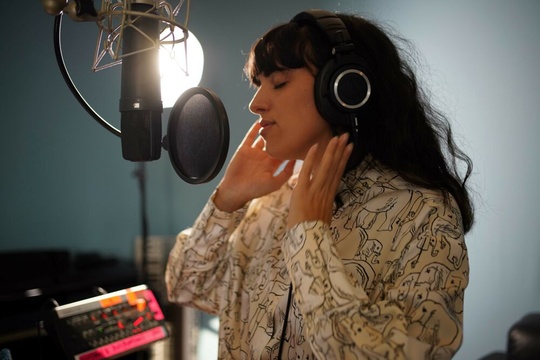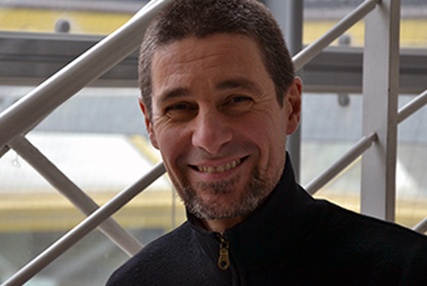Dans le cadre de sa résidence en recherche artistique sur le harnais multimodal, l’un des principaux objectifs d’Alberto Gatti était la composition de musique destinée à ce mode de diffusion unique en son genre. Pour l’accompagner dans son long processus créatif, il a fait appel à une soprano bien connue pour son appétit pour les aventures musico-technologiques : Anaïs del Sordo. Elle lève pour nous le voile sur cet atelier de composition à nul autre pareil.
 Vous êtes une habituée des studios de l’Ircam ; vous avez notamment « joué » avec les différents outils d’improvisation humain/machine. Qu’est-ce qui vous séduit dans ce genre de projets et d’expériences technologiques ?
Vous êtes une habituée des studios de l’Ircam ; vous avez notamment « joué » avec les différents outils d’improvisation humain/machine. Qu’est-ce qui vous séduit dans ce genre de projets et d’expériences technologiques ?
Ayant fait mes études dans le domaine de la musique afro-américaine et ayant choisi de me spécialiser plus particulièrement dans l’improvisation et la recherche vocale à tous les niveaux, l’idée d’une collaboration avec l’Ircam est venue tout naturellement. D’abord avec l’équipe du projet REACH, dirigée par Gérard Assayag, grâce à qui j’ai eu la merveilleuse opportunité d’interagir pour la première fois avec une « intelligence artificielle », en improvisant avec Somax2.
Je crois que l’interaction avec l’intelligence artificielle est pour nous autres, interprètes « acoustiques », une excellente occasion d’approfondir nos recherches personnelles car elle peut nous permettre d’écouter différemment, d’entrevoir d’autres facettes de nous-mêmes et de faire face à l’imprévisibilité de l’action sonore au sens large. En tant qu’improvisatrice, je ne peux que souhaiter faire face à l’aléatoire et à l’imprévisible.
Depuis l’automne dernier, vous collaborez avec Alberto Gatti dans le cadre de sa résidence : qu’est-ce qui vous séduit particulièrement au sujet du harnais multimodal et, par extension, à l’idée de créer de la musique pour/avec ce harnais ?
J’avoue que la première fois que j’ai pu moi-même le tester, j’ai ressenti quelque chose de vraiment nouveau, c’était impressionnant. Le simple fait d’entendre physiquement le son amplifié via ma propre structure osseuse, sans passer par les oreilles, m’a tout d’abord choqué. L’instant d’après, j’étais convaincue. Écouter sans les oreilles peut sembler contradictoire, mais le harnais ne fait qu’amplifier la capacité de conduction des ondes sonores qu'à déjà notre squelette, le plus naturellement du monde. Seulement, la plupart d’entre nous n’a pas conscience du phénomène, l’écoute via les oreilles prenant largement le pas sur l’écoute via le corps.
Nous autres chanteurs avons toutefois l’opportunité, grâce à l’étude des résonances naturelles du corps, de comprendre le rôle des os dans l’amplification sonore. Je ne pouvais donc qu’être extrêmement fascinée par l’objet.
En tant qu’auditrice, qu’apporte selon vous ce nouvel aspect à la musique (ou plutôt, à la création multimodale) ?
C’est une expérience unique en son genre, que je conseille fortement. Grâce au son, l’auditeur.rice peut prendre conscience de son propre corps dans un sens plus personnel, plus intime et très profond. Il s’agit d’une (re)découverte de soi, vraiment exceptionnelle, porteuse d’une puissance émotionnelle totalement inédite, peut-être justement parce qu’elle ne passe pas par les oreilles.
En quoi ont consisté les séances avec Alberto ?
Le travail de recherche et de création que nous avons mené s’est articulé en plusieurs phases. Suite à notre rencontre, Alberto m’a exposé ses idées et aspirations, et nous avons immédiatement commencé à réfléchir ensemble au type de musique que nous aurions voulu que le harnais projette. Au cours de chaque session en studio, nous avons donc travaillé physiquement sur la composition en temps réel, en essayant de mettre en lumière chacune des particularités du harnais. Cela suppose, entre autres, un grand travail de la part de l’instrumentiste acoustique : afin de démontrer les capacités de la machine, je devais jouer ou chanter en choisissant parmi des matériaux sonores prédéterminés, qui pouvaient varier selon des paramètres comme la hauteur, l’intensité, la rareté, la clarté. C’est un travail technico-instrumental très exigeant, qui passe par un long processus d’essais-erreurs, jusqu’à obtenir des sons qui fonctionnent de manière satisfaisante avec le harnais.
En tant qu’interprète/créatrice, cette fois, qu’apporte selon vous ce harnais multimodal ?
Interagir avec une telle machine est extrêmement stimulant et enrichissant. Le harnais préférant certains environnements sonores, c’est-à-dire des fréquences et caractéristiques bien précises, l’interprète est amené.e à se confronter à des réalités très spécifiques. Au début, on a le sentiment d’être dans une pièce inconnue, plongée dans la pénombre, en train de tâtonner à la recherche d’un interrupteur. La curiosité aidant, cette confusion amène inévitablement vers des territoires instrumentaux inexplorés. Il m’est arrivé plus d’une fois, en studio, de chanter des sons que je n’avais jamais osé imaginer chanter auparavant. Je crois que, pour toutes celles et ceux qui, comme moi, œuvrent dans le domaine de la musique expérimentale, la perspective de ce genre de découvertes est un moteur essentiel.
Vous avez collaboré avec Alberto à la composition d’une pièce : comment se passe la performance ? À quoi doit s’attendre le public ?
Il s’agit d’une suite en cinq volets, destinée à être « écoutée » via le harnais, chacun des volets mettant en lumière les différentes particularités de la machine en relation avec une source sonore humaine (ma voix, en l’occurrence). Chaque mouvement a été travaillé individuellement, en se concentrant sur la modalité que nous voulions valoriser. Pendant que je chantais et enregistrais un passage, Alberto était en face de moi, le harnais sur les épaules, « écoutant » en temps réel et gérant les différents paramètres perceptifs du harnais pour un rendu optimal. Une fois l’enregistrement terminé, j’ai eu la possibilité de porter le harnais à mon tour et « d’écouter » ma propre performance, afin d’en noter les points forts et les éventuels éléments à réévaluer ou modifier. Au cours de la résidence, j’ai également eu l’occasion de chanter toute la composition pour des auditeurs et auditrices extérieur.e.s au projet, équipé.e.s du harnais, ce qui nous a permis d’avoir un retour immédiat sur l’efficacité de la composition et de nous ouvrir des voies d’amélioration.
Quels sont pour vous les enjeux spécifiques à l’interprétation d’une telle musique ?
Interagir avec un tel mécanisme vous met à l’épreuve à bien des égards. Tout d’abord, je crois qu’il faut une bonne dose de patience, une grande capacité à se remettre en question et une très profonde écoute analytique afin de percevoir chaque nuance sonore. Cet état d’esprit est indispensable pour être mesure d’agir musicalement afin d’optimiser l’interaction avec le harnais, sans oublier que l’effet final doit être non seulement une démonstration technique et technologique mais aussi et surtout une performance musicale ! Comme pour tout.e musicien.ne qui se respecte, il est également nécessaire d’avoir une maîtrise technique irréprochable de son instrument. On est très souvent confrontés à des choix courageux qu’on n’a pas pu anticiper, ce qui exige un savant mélange de curiosité et de témérité.
De plus, pour travailler au mieux avec les nouvelles technologies, il n’est jamais inutile de s’y intéresser, et d’avoir la volonté de se mettre à l’épreuve et d’apprendre quelque chose de complètement nouveau, ce qui peut sembler très éloigné de la réalité du monde musical au sens strict. À cet égard, je suis très reconnaissante envers Alberto de m’avoir impliquée dans le projet, car il m’a encouragée à tourner mes regards vers un univers que je connaissais peu et qui me fascine toujours plus.
![]()
Propos recueillis par Jérémie Szpirglas





